

Eucalyptus Aromas: A Mystery - Wines & Vines - Wine Industry Feature Articles. (Editor’s note: This article is reprinted with permission from the Wine & Viticulture Journal of Australia and New Zealand, where it appeared in the July/August 2012 issue.)
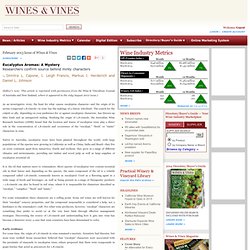
Three Sisters (agriculture) Three Sisters as featured on the reverse of the 2009 Native American U.S. dollar coin In one technique known as companion planting, the three crops are planted close together.
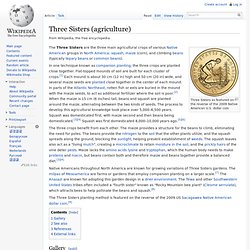
Flat-topped mounds of soil are built for each cluster of crops.[1] Each mound is about 30 cm (12 in) high and 50 cm (20 in) wide, and several maize seeds are planted close together in the center of each mound. In parts of the Atlantic Northeast, rotten fish or eels are buried in the mound with the maize seeds, to act as additional fertilizer where the soil is poor.[2] When the maize is 15 cm (6 inches) tall, beans and squash are planted around the maize, alternating between the two kinds of seeds. The process to develop this agricultural knowledge took place over 5,000–6,500 years.
Squash was domesticated first, with maize second and then beans being domesticated.[3][4] Squash was first domesticated 8,000–10,000 years ago.[5][6] How to Create a Gantt Chart Using Microsoft Excel. A Gantt chart is a popular project management bar chart that tracks tasks across time.

When first developed in 1917, the Gantt chart did not show the relationships between tasks. This has become common in current use, as both time and interdependencies between tasks are tracked. Since their first introduction, Gantt charts have become an industry standard. They are an important project management tool used for showing the phases, tasks, milestones and resources needed as part of a project. This video presentation is a step-by-step guide to creating a Gantt chart using Microsoft Excel 2007. Project Planning A Step by Step Guide The key to a successful project is in the planning. How to Plan and Schedule More Complex Projects How to create a Gantt chart step-by-step. 17 "Must Ask" Questions for Planning Successful Projects Why do some projects proceed without a hitch, yet others flounder?
Belbin's Team Roles Roles: How to Create a Line Design: 9 steps (with pictures) Edit Article Edited by Mimi, Krystle, Sondra C, Elyne and 30 others We all know that a line segment, or a line, is straight, right?

What if somebody told you that you could make curves entirely out of straight lines? With line design (also known as "string art" and "curve stitching") you can arrange a series of straight lines in a systematic way so that they create the appearance of a smooth curve, forming what is called an "envelope" in mathematics. These curves are based on mathematical formulas and can result in many complex and intriguing curves. Ad Steps. Pareto principle. Kraken. Kraken (/ˈkreɪkən/ or /ˈkrɑːkən/)[1] is a legendary sea monster of giant proportions that is said to dwell off the coasts of Norway and Greenland.
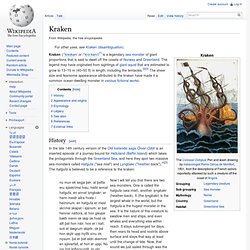
The legend may have originated from sightings of giant squid that are estimated to grow to 13–15 m (40–50 ft) in length, including the tentacles.[2][3] The sheer size and fearsome appearance attributed to the kraken have made it a common ocean-dwelling monster in various fictional works. History[edit] In the late 14th century version of the Old Icelandic saga Örvar-Oddr is an inserted episode of a journey bound for Helluland (Baffin Island) which takes the protagonists through the Greenland Sea, and here they spot two massive sea-monsters called Hafgufa ("sea mist") and Lyngbakr ("heather-back").[4][5] The hafgufa is believed to be a reference to the kraken: Confirmation bias. Tendency of people to favor information that confirms their beliefs or values Confirmation bias, also known as myside bias, is the tendency to search for, interpret, favor, and recall information in a way that confirms or supports one's prior beliefs or values.[1] People display this bias when they select information that supports their views, ignoring contrary information, or when they interpret ambiguous evidence as supporting their existing attitudes.

The effect is strongest for desired outcomes, for emotionally charged issues, and for deeply entrenched beliefs. Confirmation bias cannot be eliminated entirely, but it can be managed, for example, by education and training in critical thinking skills. Etiquette in Japan. The code of etiquette in Japan governs the expectations of social behavior in the country and is considered very important.
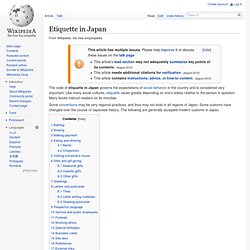
Like many social cultures, etiquette varies greatly depending on one's status relative to the person in question. Many books instruct readers on its minutiae. Bathing[edit] ESPN.com - The history and mystery of the high five. By Jon MooallemESPN The Magazine This story appeared in ESPN The Magazine's August 8, 2011, issue.
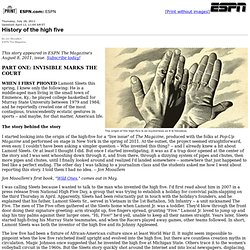
Subscribe today! WHEN I FIRST PHONED Lamont Sleets this spring, I knew only the following: He is a middle-aged man living in the small town of Eminence, Ky.; he played college basketball for Murray State University between 1979 and 1984; and he reportedly created one of the most contagious, transcendently ecstatic gestures in sports -- and maybe, for that matter, American life. I was calling Sleets because I wanted to talk to the man who invented the high five.